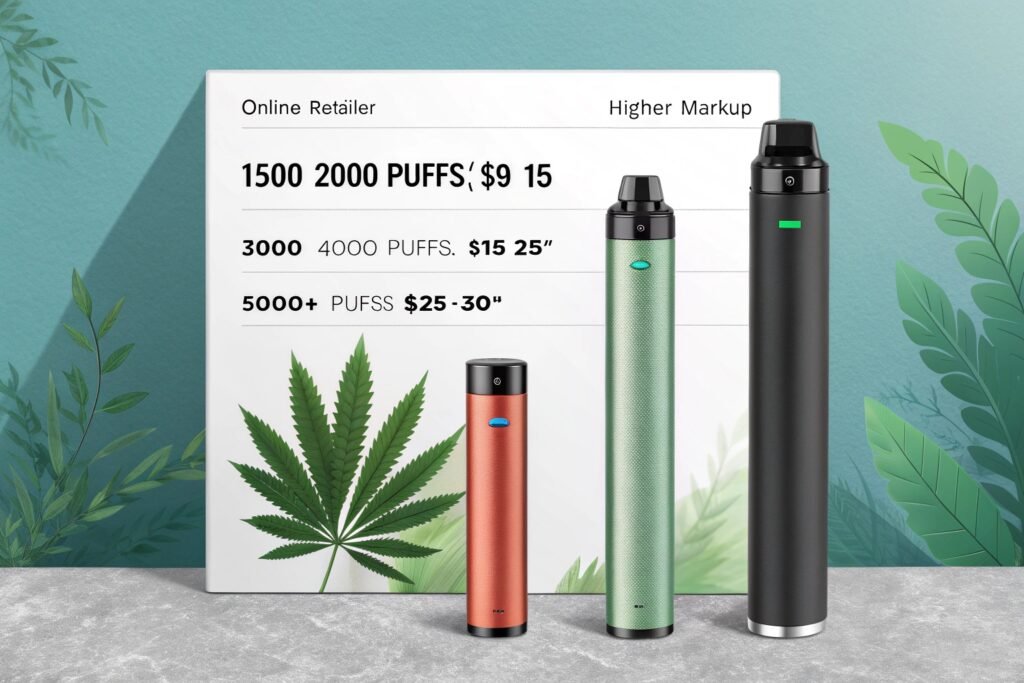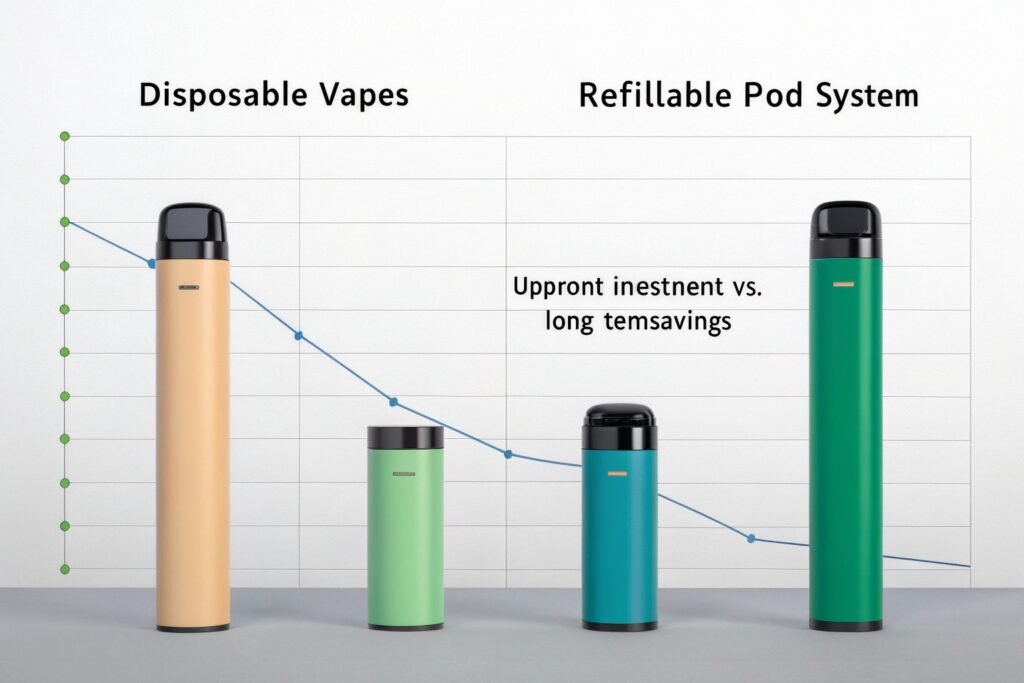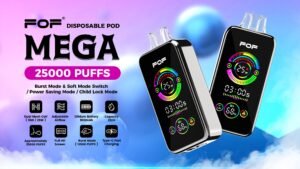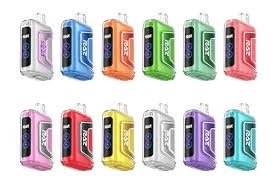Tired of overpaying for disposable vapes? Frustrated by the wide price variations for seemingly identical products? Let me share industry insights on finding affordable options without sacrificing quality.
To buy disposable vapes at cheap prices, look for authorized online retailers with bulk discounts (15-30% savings), local vape shops during sales events, wholesale clubs if purchasing multiple units, or directly from manufacturers via their websites, while avoiding gas stations and convenience stores.
 "Comparing Disposable Vape Prices"
"Comparing Disposable Vape Prices"
Having worked in vape manufacturing for years, I've gained unique insight into pricing structures across the industry. The markup on disposable vapes can be substantial—sometimes 200-300% from production cost to retail price. But finding good deals without compromising on quality requires understanding where and how to shop. Let me guide you through the options based on my experience on both sides of this business.
What's the Best Cheapest Disposable Vape?
Wondering which budget-friendly disposable vape delivers the most value? Concerned about sacrificing quality when looking for cheaper options? Here's how to identify genuinely good deals.
The best cheap disposable vapes offer 1500-2000 puffs for under $15, use quality nicotine salts, feature reliable batteries that last until the e-liquid is depleted, and come from established manufacturers with consistent quality control despite the lower price point.
 "Budget-Friendly Quality Disposable"
"Budget-Friendly Quality Disposable"
Finding that sweet spot between affordability and quality is tricky but definitely possible. Through my years working with distributors like Hustler Mega Vape, I've learned that price alone doesn't always indicate quality. Some excellent disposables sell at lower price points simply due to different business models or market positioning.
Value Indicators in Budget Disposables
When I evaluate affordable disposables, I look for several key indicators that suggest good value:
- Realistic puff counts[1]: Budget-friendly doesn't mean exaggerated claims. Honest brands offer reasonable expectations—typically 1500-2000 puffs for entry-level devices.
- Simple but effective design[2]: The best budget options focus on core functionality rather than fancy packaging or LED lights. Basic cylindrical designs with good airflow engineering often provide excellent performance.
- Focused flavor selection[3]: Instead of offering 30+ flavors of varying quality, value brands often perfect 8-12 core flavors, ensuring each works well.
- Manufacturing efficiency: Having run a vape factory, I know that streamlined production can significantly reduce costs without cutting corners on materials.
Common Cost-Cutting Measures (Good vs. Bad)
Not all cost-saving approaches are equal. Here's what I've observed:
Acceptable Cost Reductions:
- Simplified packaging
- Fewer fancy aesthetic features
- More focused flavor lineups
- Bulk component purchasing
- Direct-to-consumer sales models
Problematic Cost Reductions:
- Lower-grade batteries with inconsistent output
- Poor quality control in coil production
- Diluted e-liquid formulations
- Substandard nicotine
- Thinner plastic casings prone to cracking
When Hustler Mega Vape visits our factory to discuss OEM projects, we often talk about finding this balance—where can we reduce costs without impacting the user experience? The brands that master this balance offer the best value in the budget category.
Emerging Value Brands
The disposable market has matured enough that some manufacturers now specifically target the value segment with streamlined production and distribution. These brands typically offer:
- Direct online sales to reduce middleman costs
- Membership or subscription discounts
- Periodic sales with significant discounts
- Bulk purchase options even for individual consumers
The key is finding these opportunities before settling for overpriced options at convenience stores or gas stations, where markups are highest.
How Much Should You Pay for a Disposable Vape?
Confused about fair pricing? Wondering if you're getting ripped off or if that cheap vape is too good to be true? Let's break down what you should actually be paying for different types of disposable vapes.
A fair price for disposable vapes ranges from $9-15 for 1500-2000 puff devices, $15-25 for 3000-4000 puff options, and $25-30 for 5000+ puff models. Prices vary by location, with online retailers typically 15-30% cheaper than convenience stores or gas stations.
 "Disposable Vape Price Range Chart"
"Disposable Vape Price Range Chart"
After years in vape manufacturing and distribution, I've seen the full pricing spectrum from factory cost to retail markup. Here's my honest assessment of what constitutes fair pricing in today's market:
Price Breakdown by Device Capacity
The disposable market has stratified into several capacity tiers, each with its own price range:
Entry-Level (600-2000 puffs)
- Wholesale cost: $3-6 per unit (for large orders)
- Reasonable retail price: $9-15 per unit
- Overpriced territory: Anything over $18 for this tier
Mid-Range (2500-4000 puffs)
- Wholesale cost: $6-10 per unit (for large orders)
- Reasonable retail price: $15-25 per unit
- Overpriced territory: Anything over $30 for this tier
High-Capacity (5000+ puffs)
- Wholesale cost: $9-13 per unit (for large orders)
- Reasonable retail price: $25-32 per unit
- Overpriced territory: Anything over $40 for this tier
These price ranges assume standard features without extraordinary technologies. When I discuss pricing with distributors like Hustler Mega Vape, these benchmarks help establish fair market positioning.
Regional Price Differences
Location significantly impacts pricing due to:
- Taxes: Some states/countries have specific vape taxes[4] that can add $2-5 per unit
- Regulatory compliance costs: Stricter markets require additional testing and packaging
- Import duties: International shipping and customs can add 5-20% to costs
- Local competition: Markets with many vape shops typically have better pricing
For example, New York City or Chicago prices tend to be 20-30% higher than in areas with fewer regulations and taxes. Meanwhile, some states with minimal vape-specific taxation offer much better deals.
Sales Channel Impact on Pricing
Where you shop matters tremendously:
| Sales Channel | Typical Markup | Price Example (2000 puffs) | Value Rating |
|---|---|---|---|
| Direct from manufacturer | 60-100% over cost | $8-12 | Excellent |
| Online vape retailers | 100-150% over cost | $10-15 | Very Good |
| Dedicated vape shops | 120-180% over cost | $12-18 | Good |
| Tobacco shops | 150-200% over cost | $15-20 | Fair |
| Convenience stores | 200-300% over cost | $18-25 | Poor |
| Gas stations | 250-350% over cost | $20-28 | Very Poor |
This table reflects my observations from years in the industry and illustrates why I always recommend avoiding convenience store or gas station purchases unless absolutely necessary.
Is It Cheapest to Buy a Vape or Disposable?
Debating between investing in a refillable system or sticking with disposables? Concerned about upfront costs versus long-term savings? Let's analyze the true cost comparison over time.
Disposables are cheaper initially ($10-20 per unit vs. $30-50 for a starter kit), but refillable systems become significantly more economical after 2-3 weeks of use. A pod system plus e-liquid costs approximately $0.10-0.15 per mL, while disposables average $0.40-0.70 per mL.
 "Cost Analysis: Disposables vs. Refillables"
"Cost Analysis: Disposables vs. Refillables"
When customers ask me this question, I always give them the complete picture based on both short-term and long-term economics:
Initial Investment Comparison
- Disposable: $10-25 to start vaping immediately
- Basic pod system: $20-35 for the device + $5-15 for e-liquid + $5-10 for replacement pods/coils
- Advanced pod or mod system: $40-80 for the device + e-liquid and accessories
The disposable clearly wins on day one—there's no denying the lower barrier to entry.
Monthly Cost Projection
For a typical user consuming approximately 2ml of e-liquid daily:
Disposable Route (Month 1)
- 60mL monthly consumption
- Approximately 4-6 disposable devices needed
- Monthly cost: $40-120 depending on brand and capacity
Refillable Route (Month 1)
- Device: $30 (average pod system)
- 60mL e-liquid: $15-30
- 4 replacement pods/coils: $12-20
- Month 1 total: $57-80
- Subsequent months: $27-50 (liquid + pods/coils only)
The Breakeven Analysis
Based on these figures, the typical breakeven point occurs around 3-4 weeks of use. After this point, the refillable system becomes increasingly economical with each passing month.
I've watched many customers make this transition after initially being attracted to disposables. Tommy, my distributor client, noticed this pattern too—many of his customers start with disposables for convenience but graduate to refillable systems as they become more committed to vaping and more conscious of the ongoing costs.
Hidden Costs and Benefits
Beyond the direct price comparison:
- Battery degradation[5]: Refillable devices may need replacement after 1-2 years
- Technology improvements: Upgrading temptation for refillable users
- Flavor experimentation[6]: Refillable systems allow cheaper sampling of many flavors
- Environmental cost[7]: While not a direct financial factor, disposables create substantially more waste
When I advise new vapers, I often suggest starting with a quality disposable to ensure they enjoy vaping before investing in a refillable system. This approach minimizes wasted money if they decide vaping isn't for them.
What Is the Cheapest Way to Get a Vape?
Searching for the absolute lowest prices on vapes? Wondering if there are insider strategies for maximum savings? Here are proven approaches to minimize what you pay.
The cheapest way to get vapes is through online bulk purchases during sale events (especially holiday sales), buying directly from manufacturer websites with first-time customer discounts, using price comparison tools, or through vape subscription services that offer member pricing.
 "Finding the Best Vape Deals Online"
"Finding the Best Vape Deals Online"
Having worked on both manufacturing and retail sides of the vape industry, I've observed how the savviest consumers find the best deals. Here are the most effective strategies:
Timing Your Purchases
Sales cycles in the vape industry follow predictable patterns:
- Major holiday sales: Black Friday/Cyber Monday typically offer the deepest discounts (20-40% off)
- End-of-quarter clearances: March, June, September, December often see retailers trying to meet sales targets
- New product launches: When newer models release, previous generations often get discounted
- Site-wide sales events: Many online retailers run monthly or seasonal promotions
From my experience running promotions at FOF Vape, I've seen that timing purchases around these events can save consumers 15-30% compared to regular pricing.
Bulk Purchasing Power
The price-per-unit drops significantly with quantity:
- Single unit: Full retail price
- 3-5 units: Often 5-10% savings
- 10+ units: Typically 15-25% savings
Consider organizing group purchases with friends or buying your anticipated monthly supply at once to leverage these discounts.
Alternative Sales Channels
Some lesser-known but legitimate purchasing options include:
- Manufacturer direct programs: Some brands sell direct-to-consumer at near-wholesale prices
- Membership clubs: Vape subscription services often provide significant discounts to members
- Online forums and communities: Group buys organized in vaping communities
- Affiliate programs: Some retailers offer referral credits for bringing new customers
When Tommy was first building his distribution business, he would sometimes make retail-level purchases through these channels before establishing direct wholesale relationships. The savings were substantial enough to make it worthwhile.
Combining Strategies for Maximum Savings
The most cost-conscious consumers I've encountered use multiple approaches simultaneously:
- Wait for a major sale event
- Purchase in bulk
- Apply coupon codes (often available through vape review sites)
- Utilize free shipping thresholds
- Join loyalty programs for additional discounts or cashback
I've seen customers achieve 40-50% below standard retail pricing by patiently applying all these strategies together.
Quality Considerations
While hunting for deals, be cautious about:
- Counterfeit products: Prices that seem too good to be true often are
- Very old stock: Some extreme discounts apply to inventory that's been sitting for too long
- Gray market goods: Products imported through unofficial channels may lack warranty or support
Having seen the production side, I can confirm that even legitimate factories sometimes have "B-stock" that doesn't meet full quality standards but still gets sold through certain channels at deep discounts.
Which Country Has the Cheapest Vapes?
Curious about global price differences? Wondering if importing from abroad could save you money? Learn which countries offer the lowest vape prices and what affects these international price variations.
China has the cheapest vapes globally as the manufacturing center, with prices 30-60% lower than Western markets. Other affordable markets include Malaysia, Philippines, and Poland, but importing involves shipping costs, potential customs fees, and compliance issues that often eliminate savings.
 "Global Vape Price Comparison")
"Global Vape Price Comparison")
As someone who has worked extensively in international vape manufacturing and distribution, I've observed the significant price variations across global markets. Here's my breakdown of the global pricing landscape:
Manufacturing Hubs: Lowest Base Prices
China dominates global vape production, with over 90% of devices manufactured there. This creates:
- Factory-direct pricing[8]: In Shenzhen's vape district, retail prices can be 50-70% lower than Western markets
- Emerging competition[9]: Besides established brands, countless smaller manufacturers compete primarily on price
- Bulk availability[10]: Easy access to wholesale quantities even for individuals
When I first entered the industry working at a vape factory, I was amazed at the domestic Chinese pricing—often just 30-40% of what the same products sold for internationally.
Regional Pricing Factors
Several elements create price disparities between countries:
- Tax structures: Some countries have specific vape taxes that dramatically increase prices
- Import duties: Can add 5-35% depending on country
- Regulatory compliance costs: Markets with stricter regulations require additional testing and specialized packaging
- Market maturity: Competitive markets with many sellers typically have lower margins
- Local purchasing power: Pricing often adjusts to local economic conditions
Country-by-Country Price Comparison
Based on my observations and work with international distributors like Tommy, here's how different markets compare for a typical 2000-puff disposable vape:
| Country | Typical Retail Price (USD) | Price Relative to US | Key Factors |
|---|---|---|---|
| China | $4-8 | 30-50% | Manufacturing source, huge competition |
| Malaysia | $8-12 | 50-70% | Developing market, lower taxes |
| Philippines | $9-13 | 55-75% | Growing market, lower overhead |
| Poland | $10-15 | 60-85% | Lower EU taxes than neighbors |
| USA | $15-20 | 100% (baseline) | Varied state taxes, mature market |
| UK | $15-22 | 100-120% | Regulated market, VAT included |
| Canada | $18-25 | 110-140% | Provincial taxes, stricter regulations |
| Australia | $25-35 | 160-200% | Heavy regulation, prescription model |
The Reality of International Purchasing
While these price differences seem significant, several factors often counteract potential savings:
- Shipping costs: International shipping can add $15-30, eliminating savings on small orders
- Customs fees and taxes: Often applied upon arrival, sometimes with additional processing fees
- Delivery delays: International shipping can take weeks instead of days
- Warranty concerns: International purchases often lack local warranty support
- Compliance issues: Products made for other markets may not meet local regulations
- Payment complications: International purchases sometimes trigger fraud alerts or require specialized payment methods
During my time at FOF Vape, we noticed that individual consumers rarely found it worthwhile to import directly unless they were making very large purchases. The exceptions were travelers who could purchase while
[1]: Understanding realistic puff counts helps you choose a disposable vape that offers true value for your money.
[2]: Exploring effective designs can guide you to vapes that prioritize performance over unnecessary features.
[3]: Learning about flavor selection can enhance your vaping experience by ensuring quality over quantity.
[4]: Understanding vape taxes can help you navigate pricing differences and find the best deals in your area.
[5]: Understanding battery degradation is crucial for making informed choices about vaping devices and their longevity.
[6]: Exploring flavor experimentation can enhance your vaping experience and help you find your perfect flavor match.
[7]: Learning about the environmental impact of vaping can guide you towards more sustainable choices in your vaping journey.
[8]: Understanding factory-direct pricing can help you find the best deals and understand market dynamics in the vape industry.
[9]: Exploring emerging competition can provide insights into market shifts and new opportunities in the vape sector.
[10]: Learning about bulk availability can help you make informed purchasing decisions and save money in the vape market.





